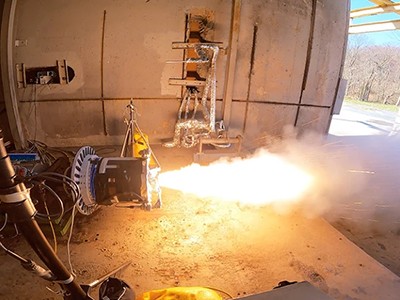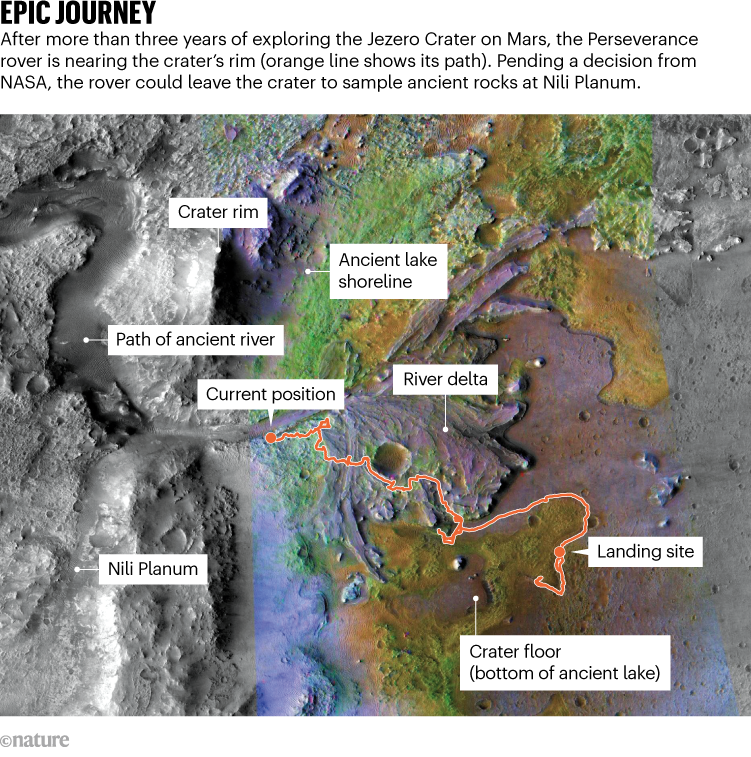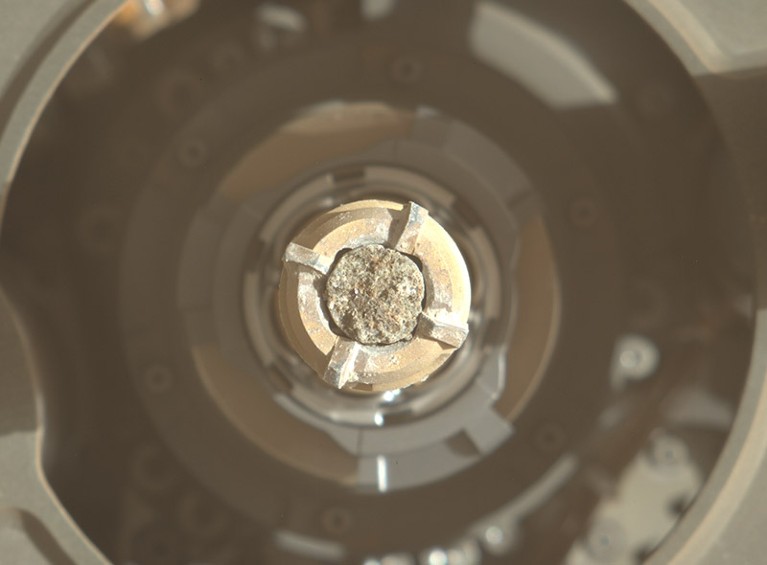The Perseverance rover drills a rock core from the edge of the ancient river delta in Jezero Crater on Mars.Credit: NASA/JPL-Caltech
The Woodlands, Texas
Scientists are on edge as they wait for NASA to answer two of the most consequential questions in Mars exploration. Where on the red planet will the Perseverance rover collect its final rock samples? And can NASA and the European Space Agency (ESA) even afford to fly the mission’s hard-won samples — the prize at the end of a decades-long quest — back to Earth?

Flying Mars rocks to Earth could cost an astronomical $11 billion
Over the past few years, Perseverance has been exploring an ancient river delta in Mars’s Jezero Crater, with the aim of finding signs of past life. The rover’s belly is now stuffed with 17 tubes of Martian rock, dirt and air that scientists say represent an astounding geological collection. “The science is only getting better as we see what Perseverance keeps collecting,” says Laurie Leshin, director of NASA’s Jet Propulsion Laboratory (JPL) in Pasadena, California. But the rover’s instruments aren’t sophisticated enough to determine whether molecules in the samples point to signs of life, or to determine the samples’ age, and so reveal something about the history of Mars. For that, laboratories on Earth are needed.
However, bringing Perseverance’s samples back could cost as much as US$11 billion, an independent panel concluded in a scathing engineering analysis last year. That’s more than NASA can afford. By the end of this month, it and ESA are supposed to find a cheaper way to achieve Mars sample return — or risk leaving the carefully collected rocks where they are.
Adding to the drama, Perseverance’s planners are debating what other science the rover should do before it has to stop exploring. The original mission plan was to explore the ancient river delta and then drive up out of the crater — where there are even older rocks that could tell scientists more about the history of Mars. But as Perseverance approaches Jezero’s rim (see ‘Epic journey’), some engineers are advocating for it to turn around and wait at a lower altitude, where it might be safer and cheaper to pick up the samples.

Source: Nature adaptation from NASA/JPL-Caltech/MSSS/JHU-APL/Brown University
John Mustard, a planetary scientist at Brown University in Providence, Rhode Island, wants the rover to stick to the original plan. The rocks currently on board are “great, but they’re not sufficient to be the transformative samples that we want them to be”, he says. “They’re not Apollo-scale,” he adds, referring to the Moon rocks collected by Apollo astronauts in the 1960s and 1970s that revolutionized scientific understanding of the Moon and Earth.
He and other scientists pressed the case for exiting the crater last week at the Lunar and Planetary Science Conference in The Woodlands, Texas. All eyes are now on NASA to see what it decides.
“Right now what we can say is, we’re committed to [Mars sample return] being the best value,” says Lindsay Hays, acting lead scientist for Mars sample return at NASA headquarters in Washington DC. “My focus is really on making sure that we get as much science out of what we can get.”
A long quest
NASA has been working on various concepts for bringing rocks back from Mars since the 1980s. Perseverance, the fifth in a string of increasingly sophisticated Mars rovers from the agency, landed in Jezero in 2021 to maximize scientists’ chances of finding signs of past life, if it ever existed. Jezero was once filled with water: a river flowed into it that created an ancient delta similar to those on Earth, which can preserve organic material — usually the remnants of plants and other organisms that came from upstream.

NASA Mars rover to cache first rock samples for delivery to Earth
So far, Perseverance hasn’t spotted any obvious signs of ancient life, such as fossils, with its cameras. The best chance of finding past Martian life would be to analyse the rocks the rover has collected for materials rich in carbon, including organic compounds, that might have been created by the decay of long-dead organisms, says Tanja Bosak, a geobiologist at the Massachusetts Institute of Technology in Cambridge. This analysis would need to happen on Earth.
Two of the rock cores are particularly promising for this; they are fine-grained mudstones from the delta that could have trapped organic material. Other cores collected by Perseverance include once-molten rocks from the crater floor that could be analysed to determine the age of that region; sedimentary rocks from the river delta that hold a history of how Mars’s climate and habitability changed through time; and rocks from the delta’s edges that appear to have interacted with deep groundwater, another potentially habitable environment, for long periods.
Stay or go?
The rover is currently exploring a narrow band of rock near the crater’s rim that is rich in carbonate minerals. On Earth, carbonates commonly form along lake shorelines and can preserve evidence of life. But scientists are still debating whether Jezero’s band represents an ancient shoreline.
In the coming months, the rover will roll onto the rim; after that, the question is whether it will leave the crater. If so, it would explore ‘basement’ rocks from around 4 billion years ago — older than the 3.5-billion-year-old delta — and fossilized hydrothermal vents that could have been a haven for Martian life.

When Perseverance drills a rock core such as this one, collected in October 2023, with its robotic arm, it then seals the specimen in a sample tube for safekeeping.Credit: NASA/JPL-Caltech/ASU
But going to this region, known as Nili Planum, might involve more risk than NASA is now willing to take. One concern is that Nili Planum is several hundred metres higher than the crater floor, so the atmosphere above it is thinner, making it more difficult — and expensive — for a sample-retrieval mission to land there.
Scientists are also concerned about how much farther the rover can physically roll before it gives out. Perseverance has travelled nearly 25 kilometres since landing, but mission scientists think it might be able to cover another 70–90 kilometres. If this is confirmed by testing at JPL, it might be able to reach some of Nili Planum’s most intriguing rocks, which are around 16 kilometres from the rover’s current location, and then make it back into the crater for pick up. If Perseverance does die unexpectedly, it has already left a backup collection of ten cores on the floor of Jezero Crater.
Budget constraints
Now the focus turns to money and how much NASA can invest in bringing the samples back. The mission is part of NASA’s planetary sciences portfolio, which currently spends $2.7 billion annually.

Mars rocks await a ride to Earth — can NASA deliver?
NASA has said it doesn’t want to spend more than 35% of its budget on the mission to retrieve the samples in any given year. “Whatever we implement for Mars sample return is going to be done in the context of a balanced planetary science portfolio,” Lori Glaze, director of NASA’s planetary sciences division, told the conference. But the uncertainty about how much funding might be available to work on Mars sample return forced JPL to lay off 8% of its employees last month.
Much of the cost for Mars sample return comes from its complexity. According to current plans, NASA would build a lander to retrieve the samples and a rocket to carry them off the surface to orbit Mars. ESA would contribute a spacecraft that would capture the samples in Mars orbit and transfer them to Earth. ESA has not discussed its budget for Mars sample return as publicly as NASA has, but European planetary scientists have expressed “consistent and strong science support” for the programme, says Gerhard Kminek, ESA’s lead scientist for Mars sample return in Noordwijk, the Netherlands.
If NASA and ESA can figure out a path forwards, the rock collection would touch down on Earth no earlier than 2033. Meanwhile, the agencies have competition: China has announced plans to return Mars rocks to Earth at around the same time.


